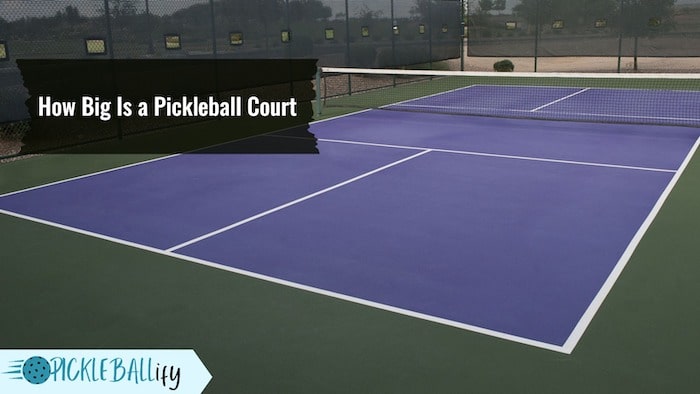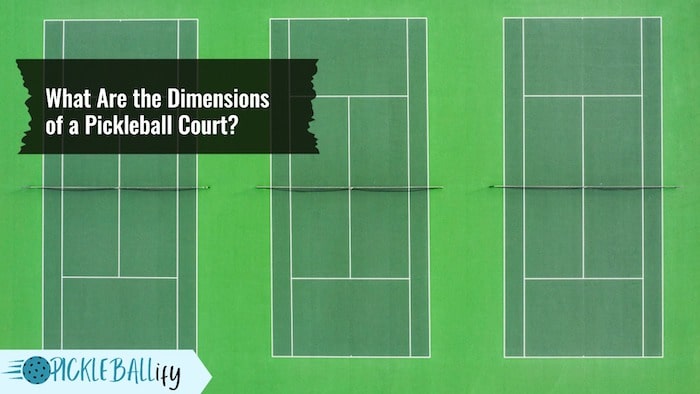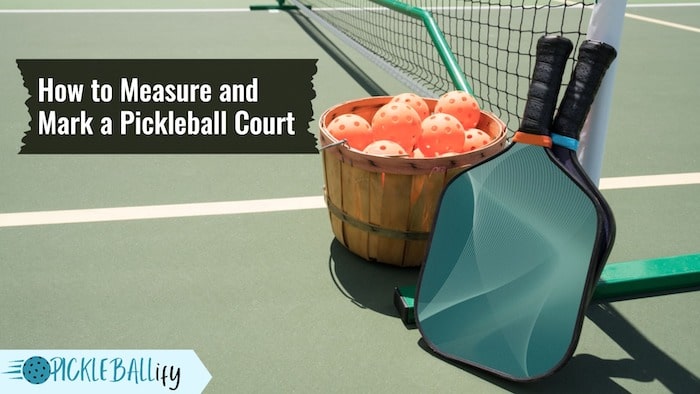Are you prepared to get started playing?How Big Is a Pickleball Cour. But before you can begin playing, you must first understand the fundamentals, beginning with and how big is a Pickleball Court.

If you’re new to the sport, don’t worry; we’ve got you covered! In this post, we’ll study the measurements of a standard pickleball court and dive into the thrilling world of pickleball. We’ll also include some fun alternatives to keep things fresh.
Prepare to ace your game and amaze your opponents, whether you’re a seasoned veteran or a total newcomer. Let’s get started!
What Are the Dimensions of a Pickleball Court
A pickleball court is the same size as a doubles badminton court. It measures 20 feet by 44 feet (6.1 meters by 13.4 meters). The court is divided into two equal halves by a net that is 36 inches (0.91 meters) high at the sidelines and 34 inches (0.86 meters) high at the center23.

The court has several lines that mark different zones and areas. These include:
- The baseline: The line at the end of each court half that marks the boundary for serving and receiving.
- The sideline: The line at the side of each court half that marks the boundary for playing.
- The centerline: The line that runs perpendicular to the net from the baseline to the non-volley zone line.
- The non-volley zone line: The line that runs parallel to the net at 7 feet (2.13 meters) from it on both sides of the court.
- The non-volley zone: The area between the net and the non-volley zone line on both sides of the court. Also known as the “kitchen”, this area is where players are not allowed to hit the ball in the air (volley) before it bounces.
The Layout of a Pickleball Court
The layout of a pickleball court is similar to a tennis court, but with some differences. Here are some of the main features of a pickleball court layout:
- The net: The net splits the court into two halves and acts as a barrier for players to knock the ball over. There should be no holes or sagging in the net, and it should be tight and level. The net posts should be placed beyond the sides rather than on them.
- The non-volley zone: The non-volley zone is the area in which players are not permitted to strike the ball in the air before it bounces. It’s also known as the “kitchen” since it’s where you’ll get “burned” if you try to volley there. The non-volley zone on both sides of the court extends 7 feet from the net and includes the non-volley zone line.
- The service courts: The service courts are where the ball is served and received. The midline divides them into two equal sections: the right service court and the left service court. The server must strike the ball from behind the baseline into the receiver’s diagonal opposite service court. To accept the serve, the receiver must stand in the proper service court.
How to Measure and Mark a Pickleball Court
If you want to create your own pickleball court, you will need some tools and tips to measure and mark it correctly. Here are some of the things you will need:

1) A tape measure: You’ll need a sellotape measure that’s at least 50 feet long. You may alternatively use two tape measures, one 25 feet long and one 50 feet long, to make marking the diagonal points easier.
2) A chalk or a marker: To mark the points and lines on the ground, you’ll need chalk or a marker. You may use any visible and easily removed color.
To draw the lines on the ground, you’ll need sellotape or paint. You may use either green Frog Tape, which is sticky and leaves no residue, or line paint, which is more permanent and lasting.
- Step 1: Mark the net’s center point. You may pinpoint the center of the net using a tape measure and mark it with chalk or a marker.
- Step 2: Make a note of the baseline points. Measure 22 feet from the center point of the net on each sides using a sellotape measure and mark them with chalk or a marker. These are the starting points for determining the length of the court.
- Step 3: Make a note of the sideline points. To measure 44 feet from each baseline point at a right angle, use two tape measures, one 25 feet long and one 50 feet long. To ensure a 90-degree angle, you can alternatively use a carpenter’s square or a right-angle triangle. Use chalk or a marker to highlight these spots. These are the sideline positions from which you will begin measuring the court’s width.
- Step 4:Use tape or paint to connect the baseline and sideline points. You should have a rectangle 20 feet by 44 feet in size. This is the layout of your pickleball court.
- Step 5: Make a note of the centerline points. Measure 10 feet from each sideline point along the baseline using a tape measure and mark them with chalk or a marker. These are the centerline positions from which the service courts will be measured.
- Step 6: Tape or paint the centerline points together. From one baseline to the next, you should have a line that runs perpendicular to the net. This is the dividing line between your court’s two sections.
- Step 7: Make a note of the non-volley zone line points. Measure 7 feet from each centerline point along the net using a sellotape measure and mark them with chalk or a marker. The non-volley zone line points are where you will begin measuring the non-volley zone.
- Step 8: Tape or paint the non-volley zone line points together. On both sides of the court, a line should run parallel to the net and 7 feet away from it. This is the line that defines your non-volley zone, sometimes known as the “kitchen.”
- Step 9: Make a note of the service court points. Measure 15 feet, 22 feet, and 29 feet from each baseline point along the sideline with a tape measure and mark them with chalk or a marker. Repeat this process for each non-volley zone line point along the centerline. These are the service court points from which the service courts will be measured.
- Step 10: Tape or paint the service court points together. From each sideline to each centerline, four lines should run perpendicular to the net. These are your service court lines, which split your court into four service courts, one on each side (right and left).
How to Find or Create a Pickleball Court: Options and Resources
If you don’t have the space, time, or budget to build your own pickleball court, you can still find or create one in your area. Here are some of the options and resources you can use.

- Find an existing pickleball court near you – You can use online tools such as Places2Play.org, Pickleball Finder, or Pickleball Court Map to locate pickleball courts in your vicinity. You can also contact your local USAPA ambassador or club to get more information about pickleball venues and events in your region.
According to USAPickleball “Before altering an existing surface, be sure to obtain proper permission from the facility owner. Temporary taped or adhered lines may leave residue on the court when removed. If permission is granted, be sure to test in a small, inconspicuous area first.“
- Convert an existing court into a pickleball court – You can use an existing tennis, basketball, badminton, volleyball, or inline hockey court to play pickleball. You can either add permanent or temporary lines and nets to adapt the court to pickleball dimensions and rules. You can also use portable pickleball nets and paddles to set up a pickleball court anywhere you want.
- Create a makeshift pickleball court – If you don’t have access to any existing court, you can still create a makeshift pickleball court in your backyard, driveway, garage, basement, or any flat surface. You can use chalk, tape, rope, cones, or any other markers to create the lines and boundaries of the court. You can also use any net, fence, rope, or string to create the net. You can also improvise with any paddle, racket, or bat and any ball that bounces well.
FAQs
Certainly, depending on the available area, some courts may be somewhat smaller or larger. Nevertheless, the length-to-width ratio should always be 2:1.
Pickleball courts are most typically played on concrete or asphalt outdoor surfaces. Indoor courts are frequently constructed of wood or synthetic materials.
Because the dimensions are similar, pickleball can be played on a tennis court. The net height, however, may need to be adjusted, and the court lines may need to be taped or painted on.
Absolutely, the size of the court has an influence on the game’s tempo and the sorts of shots that are most effective. A smaller court, for example, may need greater finesse and quick reactions, but a larger court may allow for more power and strategic placement.
Pickleball is traditionally played in doubles, with two players on each side of the court. Singles games, with one participant on each side of the court, are also conceivable.
Well, That’s a Wrap
Knowing the size of a pickleball court is a fundamental aspect of the game. It’s essential for understanding the rules, setting up the court, and practicing effectively. By understanding the standard dimensions of a pickleball court, as well as the variations that can exist, you’ll be better equipped to enjoy the game and improve your skills.
Remember, whether you’re playing for fun or competing at a high level, pickleball is a sport that can be enjoyed by people of all ages and skill levels. So get out there, hit some balls, and have a blast on the court!

